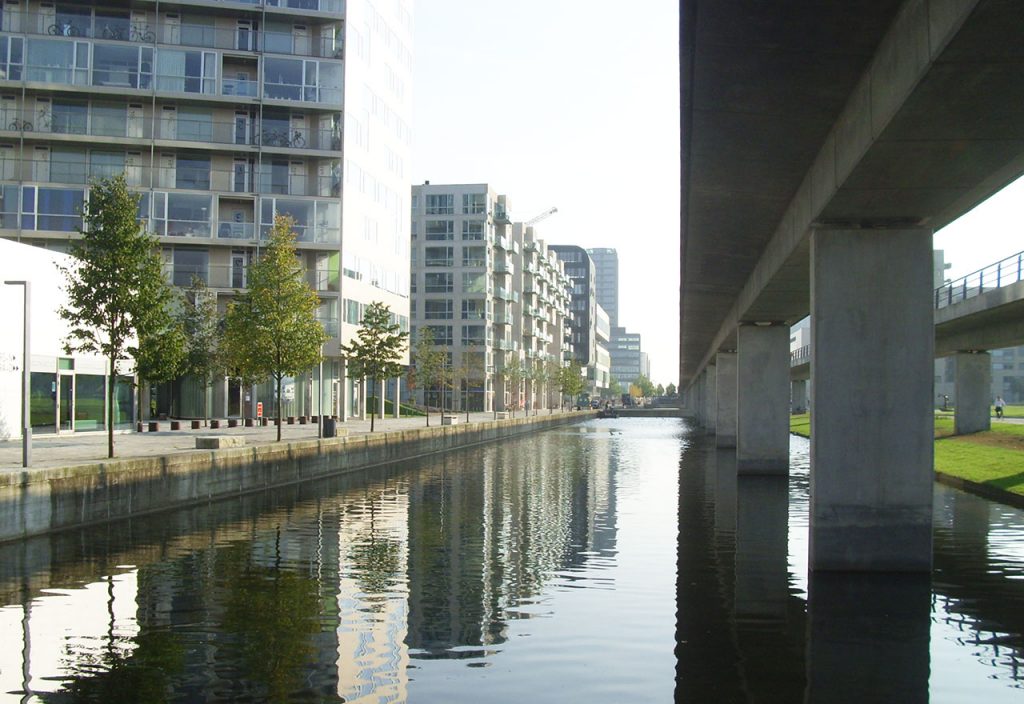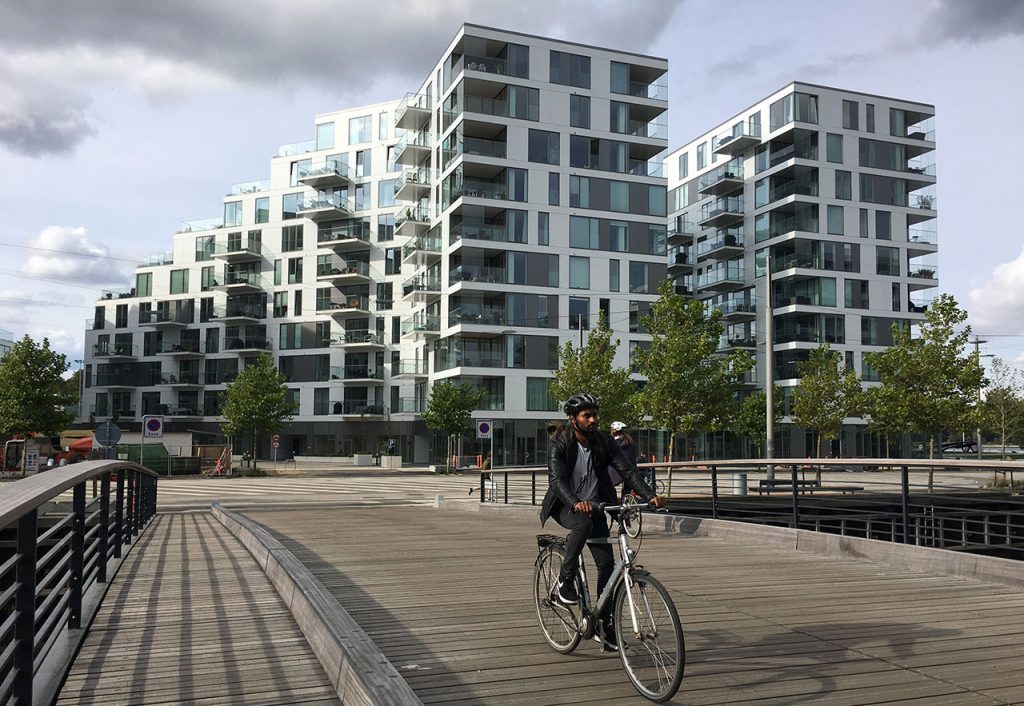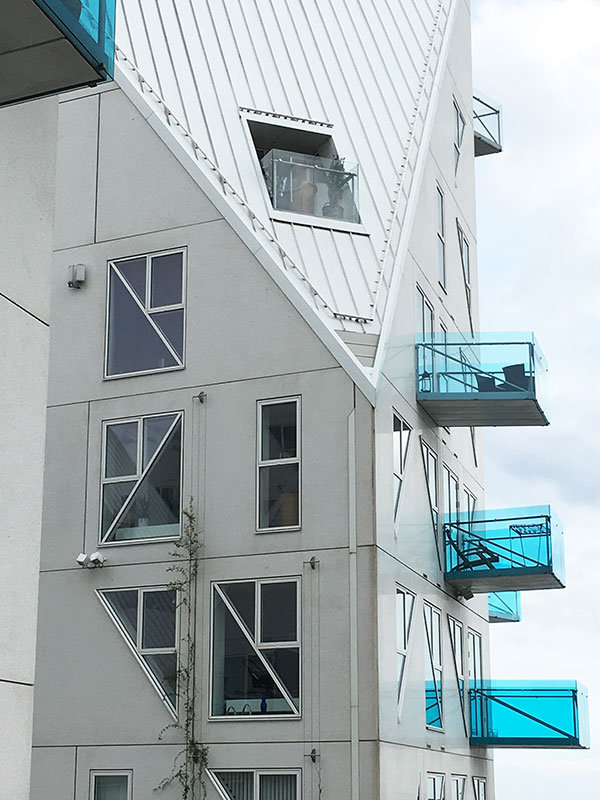Dr Nicholas Falk AoU discusses the Danish approach land value capture and strategic planning
As the UK seems to have lost its way over the last few decades, and our cities are no longer the models they once were, many — like Sir Peter Hall — have suggested learning from what has worked so well in the rest of Northern Europe. In particular, we need to ask how countries like Germany and Denmark have largely avoided the perils of house price inflation and created much healthier and wealthier societies — measured, for example, in their speedier recovery from the Coronavirus epidemic.
I am going to focus on the lessons from Denmark, and Copenhagen in particular, which go far beyond the pleasures of hygge (cosiness and comfortable conviviality) and hand-knitted sweaters! Further information is set out in the case study in Good Cities Better Lives, which focuses on conserving resources in Scandinavia1, and in the article ‘Applying land value capture tools‘ for Urban Maestro.
Denmark, like the UK, is relatively compact, densely populated and surrounded by water. Lacking natural resources, its early inhabitants the Vikings set off to conquer other countries, and much of eastern England was covered for centuries by the Danelaw. Indeed, before William the Conqueror, kings like Cnut were of Danish origin.
But Denmark, like much of Scandinavia, retained an egalitarian culture, while building up a large empire, which it had lost by the Second World War (though it had redistributed land to farmers in the 18th century.) It further suffered from economic decline, so that Copenhagen in the 1980s was a pale shadow of the imperial capital it had once been. The city had unemployment rates as high as 17.5%, the tax base had dried up, and there was extensive migration to the suburbs2. By 1995, the situation was so severe that local government halted construction of all social housing.
Strategic planning
Like neighbouring Germany and the Netherlands, Denmark has sought to make best use of its limited land, create efficient industries employing highly skilled (and well-paid) people, and plough wealth back into its towns and city centres. Denmark pioneered commercial wind turbines in the 1970s and is now a world leader in this technology.
The Danes have also been leaders in tackling climate change and, with no motor industry, have sought to make the most of public transport and, of course, cycling. So the proportion of trips by bikes in Copenhagen has risen to 37% and the planners are aiming for 50%. This is made possible not only by relatively compact and flat cities, but by progressively taking space away from cars, about 3% a year, which is enough to make a real difference over time, but not enough to generate opposition.

Copenhagen’s famous Finger Plan has concentrated development along rail transport corridors, with intensive agriculture in between. In 1992, the city and Danish state set up a development corporation to take over military land in Orestad, which is seven minutes from the central railway station and five minutes from the airport. This linear new town along a new ‘finger’ has six stations on the city’s first metro line, which has been funded from the uplift in land values.
Unlike the UK, the planning system is collaborative rather than adversarial and has spawned some amazing examples of contemporary architecture, such as blocks of apartments integrated with a multi-storey car park. By limiting development plots to between 120 and 150 units, a great diversity of styles and uses has been achieved. Social housing is indistinguishable from owner-occupied units. By creating high-density housing close to where jobs and services are located, the cost of living has been kept down. The resulting quality of life makes Copenhagen one of the highest ranked cities in the world on many surveys.
Land value capture
The key to the viability of major development schemes has been the ability of municipalities to finance infrastructure from increases in the value of land following development. What researcher Luise Noring calls Public Asset Corporations have similarities with Development Corporations, as in London Docklands, but with a longer life and shared equity3. Copenhagen set up a company, now called City and Port, to pool all the publicly-owned land in partnership between the national and local government, with the municipality owning 51% of the equity.
The company invests in the infrastructure needed for sustainable development and then sells off plots within a masterplan or development framework for the best price, with the surplus invested in public transport. One advantage is that the company retains the private freedom from political interference and shifts in policy, enabling it to weather property cycles, and create confidence in its plans.

National law requires 25% of the housing to be affordable, of which a third in urban areas is social, allocated and managed by the municipality. The co-operative tradition makes high-density living attractive to young families. Co-housing, the principle of sharing some facilities including weekly meals, accounts for some 16% of housing, and provides an attractive alternative to suburban life.
Lower housing costs make it possible to spend more time with your family and to afford well-made products, thus boosting design and craftsmanship. This spirit of collaboration extended to working with Sweden to build one of the longest bridges in the world over the Øresund, between Copenhagen and Malmö, which enables people to live in one country and work in the other.
Infrastructure first
One secret of Denmark’s success lies in the way the state has controlled land with a land value tax since 1924 based on the market price of land, revalued every two years. I found out how this worked from a leading city councillor I met at The Academy of Urbanism’s Congress in Aarhus, Denmark’s second city, when it was European City of Culture in 2018.
With a population of 330,000, the municipality employs some 20,000 staff, as it provides much more extensive services than a British equivalent. By acquiring land far in advance of development, local authorities such as Aarhus have been able to join up development with transport infrastructure, such as the new tram line. The city council buys land for future growth on the edge of the city, and leases it back to the farmers. An Expropriation Law allows the state to acquire land in the public interest, such as for roads, schools and playing fields at existing use value.
The creative role of Aarhus is most evident in the way that housing and offices have been developed overlooking the North Harbour, and in the superb new multi-purpose library. The city took over the land from the port (which it already owned) at a negotiated price, and the port facilities were relocated. It then drew up the masterplan and prepared the land so it could be developed as a series of parcels, benefitting from the views over the water. The buildings, such as one known as the Iceberg, are very stylish, with lots of green features. The new tram system, which opened in 2018, is adding value to peripheral sites the council has acquired for future development.

The principle of sharing land value uplift applies to existing housing as well as development sites. For over a hundred years, the Danes have distinguished between property taxes on the house and the land, with the latter (and larger part) going to the government, while the former is retained by the local authority. The charge is proportional to value and is probably around three times higher than the equivalent council tax in the UK for a typical house.
Land tax is based on a thousandth share of the value of the land. The tax goes first to the government and supplements income tax, which is then returned to the municipality based on a formula (as in Sweden). Property tax is set when the use is changed in the local plan, so that once a property has been zoned for housing, the relevant taxes become payable. This is a huge incentive to press on with development rather than sit waiting for values to rise, as in the UK. Of course, this reflects Denmark’s social democratic tradition associated with a constitutional monarchy and proportional representation, as well as a culture that favours conviviality and egalitarianism.
The result is a much fairer society in which natural resources are used more carefully, although problems are starting to arise as developers bid up the price of land. Overall, taxes in Denmark are high and the largest taxes are on income, but then citizens receive better services, such as childcare, and the system is less complex than in the UK. As in Sweden, the city receives a share of the income tax paid by people working there, and so has a great incentive to ensure the city prospers.
Conclusion
Danish cities reap the benefits from smarter urbanisation, and so can think 20 to 30 years ahead, rather than worrying about the next government cuts or shifts in policy. They know that a high quality of life will generate the high-paying jobs needed to support a lifestyle that is streets ahead of equivalent cities in the UK. Friendly groups of people help compensate for the cold and windy climate.
Working hours are low with lots of time off for holidays, often taken in sunnier climes. Of course, there are also drawbacks in living in a relatively small and windy northern country, however good the streets may be, which the books The Year of Living Danishly, and better still, The Almost Nearly Perfect People bring out. There are much stronger social pressures than the English are used to, and public authorities have got into financial difficulties in the past. But Denmark has reinvented itself, and so the Danes have a lot to teach us as the UK starts to think about a role outside the European Union and struggles to tackle inequalities. How can we rebuild trust in government, rather than having to rely on charity? Reforming the way taxes are charged on landed property could be the most effective way to start so that local authorities recover some of the power they have lost to central government and the private sector.
Dr Nicholas Falk AoU is executive director of The URBED Trust
1. Peter Hall (with Nicholas Falk), Good Cities Better Lives: How Europe discovered the lost art of urbanism, Routledge 2013
2. Luise Noring, Public Asset Corporation: a new vehicle for urban regeneration and infrastructure finance, Cities (Elsevier) January 2019
3. Luise Noring has helped check the substance on land value capture, and more information is available at: cityfinancelab.net/city-solutions-catalogue






